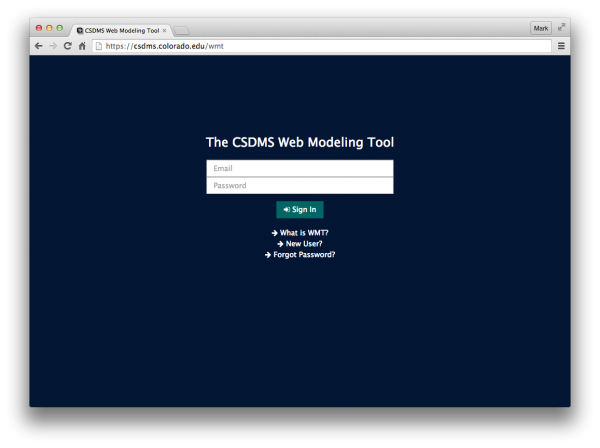WMT 1.0 release: Difference between revisions
No edit summary |
No edit summary |
||
| Line 2: | Line 2: | ||
__NOTOC__ | __NOTOC__ | ||
[[File:WMT-sign-in-screen.png|600px|right]] | |||
The CSDMS Integration Facility is happy to announce the release of version 1.0 | The CSDMS Integration Facility is happy to announce the release of version 1.0 | ||
| Line 11: | Line 13: | ||
that allows users, | that allows users, | ||
from a web browser on a desktop, laptop or tablet computer, | from a web browser on a desktop, laptop or tablet computer, | ||
to build and run coupled | to build and run coupled | ||
earth surface processes models on a supercomputer. | |||
With WMT, users can: | With WMT, users can: | ||
| Line 22: | Line 24: | ||
* Download simulation results | * Download simulation results | ||
WMT is | WMT is an MIT-licensed open source application, | ||
built entirely with open source software (Python, SQLite, Java, and Javascript). | built entirely with open source software (Python, SQLite, Java, and Javascript). | ||
The WMT source is freely available on GitHub (see links below). | The WMT source code is freely available on GitHub (see links below). | ||
We encourage CSDMS members to contribute to the | We actively encourage CSDMS members to contribute to the development of WMT | ||
by forking and cloning | by forking and cloning its GitHub repositories, | ||
then sending pull requests with improvements back to the CSDMS IF. | then sending pull requests with improvements back to the CSDMS IF. | ||
| Line 32: | Line 34: | ||
Since the introduction of a pre-release version of WMT | Since the introduction of a pre-release version of WMT | ||
at the 2014 CSDMS Annual Meeting [link?], | at the 2014 CSDMS Annual Meeting [link to presentation?], | ||
the CSDMS IF has added new features and tweaked some existing behaviors. | the CSDMS IF has added new features and tweaked some existing behaviors. | ||
Revision as of 14:29, 19 September 2015
WMT 1.0

The CSDMS Integration Facility is happy to announce the release of version 1.0 of the CSDMS Web Modeling Tool, WMT.
WMT is a web application that provides an Ajax client-side graphical interface and a RESTful server-side database and API that allows users, from a web browser on a desktop, laptop or tablet computer, to build and run coupled earth surface processes models on a supercomputer.
With WMT, users can:
- Design a model from a set of components
- Edit component parameters
- Save models to a web-accessible server
- Share saved models with the community
- Submit runs to an HPC system
- Download simulation results
WMT is an MIT-licensed open source application, built entirely with open source software (Python, SQLite, Java, and Javascript). The WMT source code is freely available on GitHub (see links below). We actively encourage CSDMS members to contribute to the development of WMT by forking and cloning its GitHub repositories, then sending pull requests with improvements back to the CSDMS IF.
New/improved features
Since the introduction of a pre-release version of WMT at the 2014 CSDMS Annual Meeting [link to presentation?], the CSDMS IF has added new features and tweaked some existing behaviors.
Links
- The primary instance of WMT resides at https://csdms.colorado.edu/wmt
- The CSDMS wiki hosts the WMT_Help page and a WMT_tutorial
- The source code for WMT can be found in three GitHub repositories:
- wmt, the data/database server: https://github.com/csdms/wmt
- wmt-exe, the execution server: https://github.com/csdms/wmt-exe
- wmt-client, the web client: https://github.com/csdms/wmt-client
